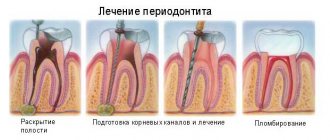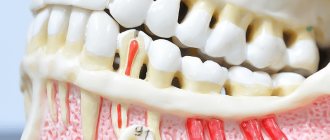White, foul-smelling balls in the tonsils
These are tonsillar plugs or stones; they form in the lacunae - the recesses of the tonsils. Their color, size, shape, and consistency depend on the composition. Most often, white lumps of soft consistency are observed; in some cases, if the composition contains calcium compounds, the lumps can be dense.
White lumps in the lacunae are formed from exfoliated old mucosal cells, bacteria and a small amount of food debris. Sometimes the lumps contain pus, and then they acquire an unpleasant odor and a yellowish tint.
You should know! When white and yellow lumps appear, a person experiences a sensation of the presence of a foreign body in the tonsils, a sore throat and bad breath.
Reasons for appearance
Experts say that the appearance of white lumps in the throat is a consequence of an inflammatory process, for example, chronic tonsillitis. This is an infectious pathology that develops against the background of weak immunity.
Provocateurs can be:
- sore throats that have not been fully treated;
- frequent consumption of cold drinks;
- ARVI and acute respiratory infections;
- smoking;
- alcoholism;
- stress;
- lack of work and rest schedule;
- bad ecology;
- work in hazardous production.
Chronic tonsillitis is caused mainly by streptococci and staphylococci, but sometimes this process can be triggered by:
- chlamydia;
- microplasma;
- viruses;
- Candida fungi.
However, the exact reasons for the appearance of white lumps in the throat are not fully known, since in some people they appear during an exacerbation of tonsillitis, while in others they do not.
According to statistics, more often white lumps appear in the throat of men.
Causes of purulent formations
Quite often, when white lumps are coughed up, most people mistakenly think that it is nothing more than leftover food that has been eaten, which has become stuck, then rotted and produces a foul odor. However, not everyone knows that this is actually a symptom of chronic tonsillitis.
The causes of sore throat, or chronic tonsillitis, are:
- respiratory diseases;
- smoking;
- weakened immunity;
- severe fatigue;
- eating very cold food and much more.
If the tonsils and mucous membrane of the pharynx are constantly inflamed, this may cause pathogenic microbes to multiply in the lacunae on the tonsils and mucous membrane, which, when accumulated in large quantities, form those very “lumps” - purulent or caseous plugs.
Often the cause of their formation is a staphylococcal or streptococcal infection. Less commonly - fungi of the genus Candida, mycoplasma, chlamydia or viruses. Such microbes can cause general intoxication of the body, expansion of tonsil lacunae and inflammation of the mucous membrane. The waste products of these microbes, dead bacteria, leukocytes and viruses become dense yellowish, grayish or white lumps that emit a strong unpleasant odor. The main problem of the disease is the spread of infection throughout the body. A natural barrier to the spread of infection and its penetration into the blood and respiratory organs are the tonsils. However, chronic inflammation leads to the fact that the tonsils are no longer able to effectively maintain protection, and viruses and bacteria can actively spread, poisoning the human body.
Possible complications
Since the function of the tonsils is a barrier - they protect the lower respiratory tract from the penetration of pathogenic flora into them, a failure in their work can lead to a large number of negative consequences. In addition, healthy tonsils are directly involved in the synthesis of lymphocytes and in the regulation of immune processes. When the tonsils are damaged, they begin to work against their own body and damage target organs:
- heart – rhythm disturbances, myocarditis, endocarditis, tonsillocardial syndrome, etc.;
- kidneys – nephritis, pyelonephritis, glomerulonephritis;
- liver – cholecystitis, toxic hepatitis;
- joints;
- genitourinary organs.
Systemic pathologies such as:
- rheumatism;
- psoriasis;
- polyarthritis;
- neurodermatitis and so on.
In some cases, the pathology may be complicated by a peritonsillar abscess, which requires immediate treatment in a hospital setting.
Important! After a sore throat or tonsillitis, it is necessary to donate blood and undergo a cardiogram in a couple of weeks in order to exclude the acquisition of another chronic disease due to tonsillitis.
Symptomatic manifestations
Chronic tonsillitis is accompanied by the following symptoms:
- Expectoration of white or purulent lumps with a foul odor. White and yellow stinking balls are coughed up not only when coughing and sneezing, but sometimes even during normal conversation. In most cases, they are no larger than a match head, but they can be quite large.
- White plaques can be observed on the surface of the tonsils, but it happens that they are concentrated in the deep layers and remain invisible.
- The patient complains of a constant sore throat, especially in the morning; sometimes this symptom can be so pronounced that the person begins to choke.
- Sore throat and redness prevent a person from swallowing saliva normally, and then food and water.
- Discomfortable sensation of the presence of a foreign body in the tonsil area, many complain of the sensation of a large lump in the throat.
- An unpleasant odor from the oral cavity, most often it is so pronounced that it can be felt by people around.
- Enlarged cervical lymph nodes.
- General malaise, aches.
- Unproductive cough - a person tries to clear his throat, but he does not always succeed.
White lumps are not always cleared up when coughing; it can also be a thick mucous mass. Its jelly-like consistency makes it difficult to cough up completely. However, a person may not be bothered by any other signs other than lumps leaving the throat .
Why are white lumps dangerous?
If there are white lumps with an unpleasant odor in the tonsils, local immunity may decrease. As a result, the infection can lead to damage to the entire body. The tonsils are a barrier that prevents infection from entering the respiratory system and blood.
Due to the constant inflammatory process, their functions are disrupted, so the virus penetrates into neighboring organs. And this is fraught with various complications:
- Deep damage to the tonsils. As a result, they become very vulnerable and not only do not perform their functions, but are also a source of infection.
- Heart dysfunction. Arrhythmia, pain in the organ area and other consequences are possible.
- Spread of infection to joints and bones. This makes them painful, a person often complains of aching in them, and deformities begin.
- Kidney problems appear. The process of urination is disrupted, during which the patient may experience cutting pain, and the color of the urine may change.
If the above symptoms occur, urgent consultation with a doctor is required. If you ignore them, the body will be weakened, so the diseases can become chronic .
Why do you need to get rid of them?
Since the presence of white lumps in the throat negatively affects the state of the human immune system, and they can give impetus to the development of complications and chronic pathologies of target organs, it is imperative to get rid of them.
Keep in mind! In addition to the complications listed above, the balance of microflora in the oral cavity is disrupted, and pathogenic microorganisms begin to actively multiply. At the same time, they can penetrate the organs of the digestive tract and provoke ulcers, dysbacteriosis and other pathologies.
What it is
Smelly lumps in the throat are tonsillar plugs that form in the lacunae of the palatine tonsils. They can be small, barely noticeable, or slightly larger. Their consistency can also change - soft, jelly-like and even hard, like pebbles (they contain calcium).
They are formed from dead mucosal cells, food particles and some bacteria present in the oral cavity (staphylococci, streptococci). If they contain pus, they turn yellow or green. At the same time, their smell is very pungent, putrid, they smell rotten.
General approach to therapy
To clarify the diagnosis, the patient is prescribed:
- general blood analysis;
- immunogram;
- ECG;
- Analysis of urine;
- throat swab.
Based on the results of these studies, the doctor can determine the severity of the pathology and select a treatment regimen that is appropriate to the situation.
The patient must be prepared for the fact that the treatment will be quite long and complex. The treatment regimen is prescribed in several directions at once :
- strengthening the immune system;
- gargling and rinsing;
- exposure to antibacterial drugs;
- physiotherapy.
Before treating chronic tonsillitis, it is necessary to get rid of caries, since carious teeth are another source of infection .
In addition, you need to adjust your diet and review your daily routine. The following is recommended:
- spend more time outdoors;
- eat more vegetables, fruits, seafood;
- take vitamin complexes, especially in the autumn-winter period;
- sleep enough time.
It's nice to visit a seaside resort.
Flushing with a syringe
This method, although old, is very effective and widespread, especially in district clinics. The procedure is carried out as follows :
- A brass replacement tip is attached to the syringe.
- The patient's larynx is treated with lipocaine to reduce discomfort.
- The lacunae are irrigated with a special solution, with the help of which purulent plugs, white lumps, bacteria and their waste products are washed out.
The procedure lasts 10 minutes and is considered traumatic , since the cannula can damage the mucous membrane if the patient twitches or if the doctor does not have enough experience. In addition, it will be difficult for those who have a particularly strong gag reflex. Moreover, to wash the tortuous passages, one procedure will not be enough; 6-10 sessions will be required, but after a couple of procedures the patient will be able to tolerate them more easily.
Washing using the Tonsilor device
Vacuum rinsing using the Tonsilor device is a more gentle way to get rid of plugs and white lumps. In this case, ultrasound is used. The full course is 5 procedures, during which the contents of the tonsils are sucked out.
Important! Remission after hardware rinsing can last a couple of years, and if you actively increase immunity during this time, then you can forget about white lumps with an unpleasant odor forever.
How is physiotherapy performed?
Washing the tonsils gives a very good effect if combined with physiotherapeutic treatment. The main goal of physiotherapy is to restore the proper functioning of the tonsils and improve blood supply to the lymph nodes. The course of treatment is 10-12 procedures. The most popular methods are :
- Ultrasound . This method has a number of contraindications, but it is absolutely painless and effectively stops the inflammatory process in the tonsils.
- UHF warming up . Eliminates swelling in the area of the tonsils and lymph nodes.
- UV irradiation . The inflammatory process is relieved using ultraviolet radiation.
- Laser therapy . The tonsils are treated with a laser, which leads to the complete elimination of swelling and inflammation. The method has no contraindications.
Inhalations, electrophoresis, and magnetic therapy may also be recommended.
Medications
Drug therapy to strengthen the immune system involves taking the following medications::
- Levamisole.
- Immunofan.
- Isoprinosine.
- Methyluracil.
- Bemitil.
- Immunomax.
Note! As for vitamins, a complex of vitamins with a high content of vitamin C is mainly prescribed. Antibacterial agents can also be prescribed, but only after analyzing the sensitivity of the bacterial flora to the components of the drugs.
While the resistance test is being carried out, the patient is prescribed antibiotics of the cephalosporin group:
- Cefepi.
- Ceftiaxone.
The dosage and duration of taking antibacterial agents is prescribed only by a doctor.
If conservative treatment is ineffective, the patient is recommended to undergo surgery.
Whitish lumps in the tonsils with tonsillitis
Exacerbation of chronic or the onset of acute tonsillitis can be recognized by the following signs:
- bad breath, a sour taste in the mouth;
- there is an increase in body temperature;
- periodically painful sensations occur during eating and swallowing;
- pain appears in the throat, head, and cervical region.
Why do purulent plugs form and what do they consist of?
Photo: this is what white lumps on the tonsils look like
Many people believe that the white things in the throat and tonsils are just small pieces of food that have begun to rot and give off a rotten smell. Residues of food are indeed present in these formations, but basically calcified miniature balls consist of dead bacteria that entered the body along with air, and leukocytes, aimed at fighting them by the human immune system.
Microorganisms that cause inflammation in the tonsils produce hydrogen sulfide. They need this substance to protect against oxidative processes and subsequent destruction of DNA; it also emits the aroma of rotten eggs, due to which the patient’s mouth begins to smell bad.
The “culprits” for the formation of yellow and white lumps on the tonsils
There are several types of microorganisms that cause a whitish coating to form on the tonsils, which gradually turns into miniature pebbles. It can be:
- Streptococci. A bacterial infection causes symptoms such as frequent vomiting, fever, abdominal pain, swollen lymph nodes, and a rash.
- Epstein-Barr virus, which causes infectious mononucleosis, can also cause white, hard lumps in the mouth that have a foul odor. The presence of the disease is indicated by the following signs: high body temperature, enlarged tonsils and pain in the larynx. In advanced cases, clots of pus may be released.
- Herpes Simplex Virus (HSV-1), leading to the development of oral herpes. Most often, the disease can be recognized by the presence of sores on the lips. Simultaneously with the appearance of bubbles on the outer surface of the lip, a whitish or yellowish coating may form on the mucous membranes of the tonsils, which later transforms into stones.
Treatment at home
If the pathology is mild, the doctor may advise treating it at home with the help of medicines or traditional medicine. However, they should only be prescribed by a specialist. Activities that can be done at home :
- Flushing the throat . To do this, you can use a solution of Furacilin, a weak solution of iodine, a solution of hydrogen peroxide, an infusion of sage or chamomile. The liquid must be drawn into a syringe without a needle and directed at the tonsils. To prevent liquid from entering the respiratory tract, the head should be tilted down over the sink. The procedure is carried out 5 times a day, after which you are not allowed to drink or eat for 40 minutes.
- Inhalations . Herbal decoctions and infusions are used - oak bark, sage, eucalyptus, chamomile. A decoction of medicinal herbs or a few drops of essential oil are added to the water heated in a bowl. You need to bend over the dishes and cover your head with a towel. You need to breathe deeply, through your mouth. It is better to carry out such procedures before bedtime. At elevated temperatures, inhalation is prohibited.
- Gargling . Indispensable helpers in the fight against white lumps in the throat are iodine, salt and soda.
- Strengthening the immune system . A tincture of echinacea or eleutherococcus is recommended.
Diagnosis of a lump in the throat
Instrumental diagnosis of a lump in the throat.
Source Photo: macniak / Depositphotos Diagnostic tests used for PCG depend primarily on the data obtained from collecting complaints and the characteristics of clinical symptoms - all of this together allows the doctor to make a preliminary diagnosis.
To confirm this diagnosis, as well as for the purpose of differential diagnosis (that is, excluding other pathologies with a similar clinical picture), the doctor prescribes a set of diagnostic tests. However, there is no uniform examination tactic. When prescribing tests, the doctor sets himself the task of excluding pathologies - tumors, ENT pathologies, changes in the volume of the thyroid gland and others.
Investigations for coma in the throat
Research methods depend on the cause. The simplest situation is with nervous stress - the doctor, based on the examination data and the patient’s complaints, will be able to get an idea of the mental state of his patient. In other cases, the patient may be prescribed blood tests, bacteriological cultures, ultrasound, MRI, radiography and other studies - not necessarily at the same time, it all depends on the preliminary diagnosis.
Blood tests
The doctor usually orders one or more tests. Depending on the type of study, the patient’s blood is taken from a finger or from a vein.
General analysis
The most common blood test, for which blood is taken from a finger (less commonly, from a vein). This study allows you to get an idea of the level of hemoglobin, red blood cells, platelets, white blood cells and ESR. If any of these indicators deviate from the norm, you can determine:
- the presence of inflammatory processes,
- anemia,
- blood clotting disorder.
The study is carried out in the morning on an empty stomach. You should not drink alcohol 2-3 days before the test, and a few hours before the test you should refrain from smoking.
Testing for tumor markers
As can be understood from the name, this test is prescribed when the development of tumor processes is suspected, when the patient experiences a constant increase in body temperature, pain, weakness, loss of appetite and weight loss. Tumor markers are a special type of proteins that are secreted by tumor cells.
Analysis to determine TSH levels
The level of thyroid-stimulating hormone (TSH) increases or decreases when the thyroid gland is not functioning properly. The basis for prescribing this study, in addition to the feeling of a lump in the throat, may be changes in appetite, nervousness, sleep disturbances, and deterioration in the condition of hair and skin. In rare cases, TSH levels increase in pregnant women.
IgE test
The study is aimed at identifying the level of IgE, that is, immunoglobulins E, which are antibodies whose level in the blood plasma of healthy people is very low. However, with allergic reactions and eosinophilic esophagitis, it increases.
Blood sampling for the above studies is carried out from a vein. A week before the test, it is advisable to limit physical activity and alcohol intake. The test is taken on an empty stomach - at least 8 hours must pass between the time of blood sampling and the last meal. It is important to refrain from smoking 1–2 hours before the test.
Sowing for microflora
Prescribed for inflammatory diseases of the throat. . The purpose of culture is to identify the causative agent of the infectious process and determine its sensitivity to antimicrobial drugs. The procedure is short and painless: the doctor uses a sterile swab to make a swab from the throat. There is another way: the patient rinses his mouth with a saline solution, and then spits it into a sterile container.
X-ray of the spine
This hardware test is prescribed to a patient if osteochondrosis is suspected. Using an X-ray of the spine, the doctor gets an idea of the condition of the bones and intervertebral joints. If an intervertebral hernia is suspected, an MRI may be prescribed as an additional study.
Esophagoduodenoscopy
This is an endoscopic examination of the esophagus, which is prescribed for suspected eosinophilic esophagitis and gastroesophageal reflux disease. The patient swallows a thin endoscope, with which the doctor evaluates the condition of the esophagus. In addition, during esophagoscopy, if necessary, a biopsy sample (a small fragment of tissue) is taken for histological examination. The procedure is unpleasant, but short. It causes the greatest discomfort in patients with a pronounced gag reflex. You should refrain from eating 6–7 hours before the test.
Salivary gland biopsy
Used in the diagnosis of Sjögren's syndrome. Biomaterial is collected not only from the salivary glands, but also from the inner mucous membrane of the cheeks. Using a syringe with a thin long needle, a puncture is made and biomaterial is collected for subsequent histological examination. This diagnostic procedure is performed under ultrasound guidance using local anesthesia. It is prescribed relatively rarely, since in most cases a blood test for autoantibodies allows a specialist to confirm or refute a preliminary diagnosis.
Ultrasound of the thyroid gland
Prescribed for the diagnosis of diffuse goiter, thyroiditis and other pathologies of the thyroid gland. This is an absolutely painless examination that does not require special preparation from the patient: you can eat, exercise, and even smoke before the ultrasound.
Contrast radiography of the esophagus
This study is relevant when diagnosing Zenker's diverticulum. With its help, the specialist gets an idea of the localization of the protrusion, as well as its size and shape. Before the x-ray, the patient is asked to drink a glass of barium suspension to improve contrast. This diagnostic procedure requires special preparation: you should not eat food 6–7 hours before the test.









